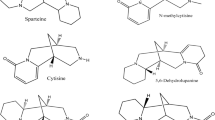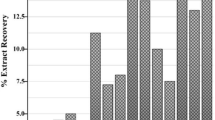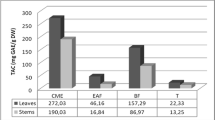Abstract
Anabasis articulata is a plant widely used in popular medicine to treat several pathologies in Algerian Sahara, such as diabetes. It is also associated with two other plants to cure certain types of cancer. Few research studies have been conducted on phytochemical analysis and in vivo biological activities of this species. However, no report is available on chemical elucidation of alkaloids and their antioxidant and antimicrobial properties. This study aims to characterise alkaloids in A. articulata stems and to evaluate their antioxidant and antimicrobial effects. Alkaloids extraction was carried out using polar (E1; E2.1; E2.2) and apolar solvents (E3), while chemical characterisation was performed by GC/MS. In vitro antioxidant activity was assessed by tree tests: total antioxidant capacity (TAC), DPPH scavenging assay and β-carotene–linoleate inhibition. For antimicrobial activity, eight different microorganisms were tested. The results suggest that E2.2 extract had the highest TAC value (14.742 ± 0.224 mg AAE/g DM), but E3 extract presented the highest DPPH scavenging activity (EC50 = 1.242 ± 0.168 mg/mL) and a strong β-carotene–linoleate inhibition (EC50 = 0.943 ± 0.027 mg/mL). In addition, E3 extract had the strongest inhibitory effects against all tested microorganisms and produced inhibition zones ranging between 9 and 20 mm, while the MICs of this extract ranged from 0.781 to >100 mg/mL and the MBCs ranged between 1.562 and >100 mg/mL. Forty-nine compounds belonging to 16 families, namely cyclopeptide alkaloids, steroid alkaloids, quinoline alkaloids, camptothecin alkaloids, quinazoline alkaloids, quinazoline alkaloids, isoquinoline alkaloids, isoquinolone alkaloids, indole alkaloids, terpene indole alkaloids, pyridine/pyrrolidine alkaloids, piperidine alkaloids, pyrrolizidine alkaloids, purine alkaloids, acridone alkaloids, benzazonine alkaloids and homolycorine-type Amaryllidaceae alkaloids were identified. Therefore, A. articulata can be considered as a source of antioxidant and antimicrobial agents.






Similar content being viewed by others
References
Abdulsahib K, Abdulkareem A, Ban Jumaa Q, Hayder S (2016) Antiangiogenesis and antioxidant effect of Anabasis articulata stems extracts. Int J Pharm Sci Rev Res 41:88–94
Alsofany RH (1998) A study of saponin content of Anabasis setifera Moq growing in Egypt. Bull Fac Pharm (Cairo Univ) 36:17–19
Ajayeoba EO, Adeniyi BA, Okogun JI (1995) Antimicrobial activity of crenatine, an alkaloid synthesized from indole. Phytother Res 9:67–71
Benhammou N, Ghembaza N, Benabdelkader S, Atik-Bekkara F, Kadifkova Panovska T (2013) Phytochemicals and antioxidant properties of extracts from the root and stems of Anabasis articulata. Int Food Res J 20:2057–2063
Chen H, Hajia A, Yang ZD, Li YC (2005) Isolation and structure identification of chemical constituents from Anabasis brevifolia. Yao Xue –Xue Bao 40:248–251
Chopra IC, Abrol BK, Handa KL (1960) With particular reference to the pharmacological aspects. In: Chopra IC, Abrol BK, Handa KL, Paris R and Dillemann G (eds) Medicinal plants of the arid zones. UNESCO Publications, Paris
CLSI (Clinical and Laboratory Standards Institute) (2012) Performance standards for antimicrobial disk susceptibility tests; approved standard—Eleventh Edition. CLSI document M02-A11. CLSI, Wayne, PA
Denyer SP, Maillard JY (2002) Cellular impermeability and uptake of biocides and antibiotics in gram-negative bacteria. Symp Ser Soc Appl Microbiol 31:355–455
Du H, Wang Y, Yan C, Zhou LG, Hao XJ (2008) Alkaloids from Anabasis aphylla L. J Asian Nat Prod Res 10:1093–1095
El-Desouky S, Kim K, Ryu S, Eweas A, Gamai-Eldeen A, Kim Y (2007) A new pyrrole alkaloid isolated from Arum palaestinum Boiss and its biological activities. Arch Pharm Res 30:927–3174
Eman AA (2011) Phytochemical screening on different plants parts of some succulent plants of Egypt. New Y Sci J 4:15–18
Ghembaza N, Belyagoubi-Benhammou N, Atik Bekkara F (2016) Separation and identification of bioactive compounds in Anabasis articulata (Forsk) Moq. Roots Nat Prod Res 30:857–859
Hammiche V, Maiza K (2006) Traditional medicine in Central Sahara: pharmacopoeia of Tassili N’ajjer. J Ethnopharmacol 105:358–367
Harborne JB (1998) Phytochemical methods: a guide to modern techniques of plant analysis. Thomson science. Ed. Chapman and Hall, London
Impei S, Gismondi A, Canuti L, Canini A (2015) Metabolic and biological profile of autochthonous Vitis vinifera L. ecotypes. Food Funct 6:1526–1538
Kalla A (2012) Étude et valorisation des principes actifs de quelques plantes du sud algérien: Pituranthos scoparius, Rantherium adpressum et Traganum nudatum. Thèse de Doctorat en Sciences. Université de Mentouri—Constantine
Kambouche N, Merah B, Derdour A, Bellahouel S, Bouayed J, Dicko A, Younos C, Soulimani R (2009) Hypoglycemic and antihyperglycemic effects of Anabasis articulata (Forssk) Moq (Chenopodiaceae), an Algerian medicinal plant. Afr J Biotechnol 8:5578–5583
Kambouche N, Merah B, Derdour AS, Bellahouel S, Younos C, Soulimani R (2011) Activité antihyperglycémiante d’un stérol β-sitoglucoside isolé de la plante Anabasis articulata (Forssk) Moq. Phytothérapie 9:2–6
Kaur R, Arora S (2015) Alkaloids-important therapeutic secondary metabolites of plant origin. J Crit Rev 2:1–8
Koduru S, Jimoh FO, Grierson DS, Afolayan AJ (2007) Antioxidant activity of two steroid alkaloids extracted from Solanum aculeastrum. J Pharmacol Toxicol 2:160–16
Kokanova-Nedialkova Z, Nedialkov PT, Nikolov SD (2009) The genus chenopodium: phytochemistry, ethnopharmacology and pharmacology. Pharmacogn Rev 3:280–306
Maatalah MB, Bouzidi NK, Bellahouel S, Merah B, Fortas Z, Soulimani R, Saidi S, Derdour A (2012) Antimicrobial activity of the alkaloids and saponin extracts of Anabasis articulata. J Biotech Pharma Res 3:54–57
Metwally NS, Mohamed AM, ELSharabasy FS (2012) Chemical constituents of the Egyptian Plant Anabasis articulata (Forssk) Moq and its antidiabetic effects on rats with streptozotocin-induced diabetic hepatopathy. J Appl Pharm Sci 2:54–65
Mohamed AM, Abdalla MS, Rizk MZ, Mahdy EM, Farrag ARH, El-Sharabasy FS, Aly FF, Mohamed MR (2014) Alleviation of Dimethylnitrosamine-induced liver injury and fibrosis by supplementation of Anabasis articulata extract in rats. Indian J Clin Biochem 29:418–429
Mohammed HA, Alshalmani SK, Abdellatif AG (2013) Antioxidant and quantitative estimation of phenolics and flavonoids of three halophytic plants growing in Libya. J Pharmacogn Phytochem 2:89–94
Manosalva L, Mutis A, Urzúa A, Fajardo V, Quiroz A (2016) Antibacterial activity of alkaloid fractions from Berberis microphylla G. Forst and study of synergism with ampicillin and cephalothin. Molecules 21:1–10
Moure A, Franco D, Sineiro J, Dominguez H, Nunez MJ, Lema GM (2000) Evaluation of extracts from Gevuina avellana hulls as antioxidants. J Agric Food Chem 48:3890–3897
Mroczek A (2015) Phytochemistry and bioactivity of triterpene saponins from Amaranthaceae family. Phytochem Rev 14:577–605
NCCLS “National Committee for Clinical Laboratory Standards” (2001) Performance standards for antimicrobial susceptibility testing: eleventh informational supplement, M100-S11, Wayne, PA, USA
Pei Y, Duo Yang ZD, Sheng J (2014) Chemical constituents of Anabasis salsa. Chem Nat Compd 50:957–958
Prieto P, Pineda M, Aguilar M (1999) Spectrophotometric quantitation of antioxidant capacity through the formation of a phosphomolybdenum complex: specific application to the determination of vitamin E. Anal Biochem 269:337–341
Quezel P, Santa S (1963) Nouvelle flore de l’Algérie et des régions désertiques méridionales. In: Tome II (ed) Éditions du Centre National de la recherche scientifique. CNRS, Paris
Sadykov AS, Tumur B (1960) The alkaloids of Anabasis aphylla var. Iljinii Doklady Akademii Nauk Uzbekskoi SSR 1:27–29
Sanchez-Moreno C, Larrauri JA (1998) Main methods used in lipid oxidation determination. Food Sci Technol Int 4:391–399
Sathiyamoorthy P, Lugasi-Evgi H, Van-Damme P, Abu-Rabia A, Gopas J, Golan-Goldhirsh A (1997) Larvicidal activity in desert plants of the Negev and Bedouin market plant products. Int J Pharmacogn 35:265–273
Scherrer R, Gerhardt P (1971) Molecular sieving by the Bacillus megaterium cell wall and protoplast. J Bacteriol 107:718–735
Segal R, Goldzweig-Milo I, Zaitschek DV (1969) The sapogenin content of Anabasis articulata. Phytochemistry 8:521
Tilyabaev Z, Abduvakhabov AA (1998) Alkaloids of Anabasis aphylla and their cholinergic activities. Chem Nat Compd 34:295–297
Zakharov VP, Aslanov Kh A, Ishbae AIv, Sadykov AS, Yankovskii BA (1974) The separation of the alkaloids of Anabasis aphylla. Chem Nat Compd 10:474–476
Author information
Authors and Affiliations
Corresponding author
Ethics declarations
Conflict of interest
The authors declare that they have no conflict of interest.
Additional information
Publisher’s note: Springer Nature remains neutral with regard to jurisdictional claims in published maps and institutional affiliations.
Supplementary material
Rights and permissions
About this article
Cite this article
Belyagoubi-Benhammou, N., Belyagoubi, L., Gismondi, A. et al. GC/MS analysis, and antioxidant and antimicrobial activities of alkaloids extracted by polar and apolar solvents from the stems of Anabasis articulata. Med Chem Res 28, 754–767 (2019). https://doi.org/10.1007/s00044-019-02332-6
Received:
Accepted:
Published:
Issue Date:
DOI: https://doi.org/10.1007/s00044-019-02332-6




